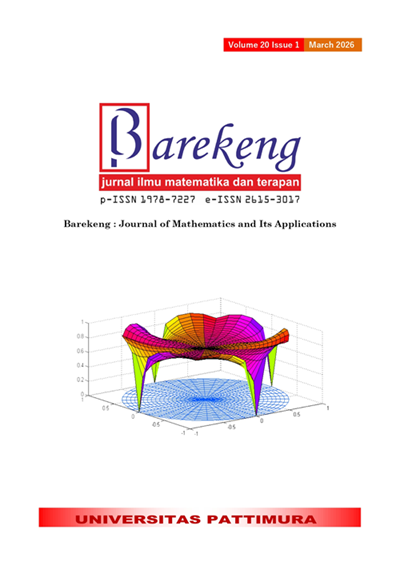LOSS INSURANCE MODEL OF RISK FOR AGRICULTURAL COMMODITY BASED ON MAXIMUM DAILY RAINFALL INDEX CONSIDERATION
Abstract
Agricultural commodities in rainfed areas face significant risks of yield loss and crop failure due to uncertain rainfall patterns and intensities. Index-based crop insurance has been introduced as an adaptive strategy to simplify loss assessment using climate indicators. However, most existing schemes cover only a single peril, such as drought. This study aims to develop a loss model of risk for agricultural commodity using maximum daily rainfall index that accounts for both drought and flood risks. The model consists of two components: rainfall modelling and insurance modelling. Rainfall modelling identifies the appropriate probability distribution to define rainfall index parameters—trigger and exit—which represent thresholds for yield reduction and total crop failure, respectively. These parameters are derived through numerical integration and can be approximated using percentiles when crop-specific water requirement data are unavailable. Insurance modelling determines a benefit claim model based on rainfall probability and parameters of rainfall index, with three possible benefit claim conditions: full, partial, and none. A case study using maximum daily rainfall data (September–December, 1984–2014) for paddy in Dramaga, Bogor, indicates that the Burr Type XII distribution fits the data better than the GEV distribution. The estimated premium ranges from IDR 300000 to 300822.9 per hectare. In high-rainfall areas like Dramaga, premiums are primarily influenced by the probability of excess rainfall, while drought risk is negligible. Analysis over a 10-year actual maximum daily rainfall data (September–December, 2015–2024) shows that lower insured percentiles result in lower premiums. To improve accuracy, trigger and exit should ideally be determined based on the specific crop's water requirements. Despite data limitations, this model provides a conceptual model for developing more representative and actuarially fair loss model for agricultural commodity risk.
Downloads
References
W. Kron, P. Löw, and Z. W. Kundzewicz, “CHANGES IN RISK OF EXTREME WEATHER EVENTS IN EUROPE,” Environ Sci Policy, vol. 100, pp. 74–83, Oct. 2019, doi: https://doi.org/10.1016/j.envsci.2019.06.007.
Z. Fatima et al., “FIELD CROPS AND CLIMATE CHANGE,” in Building Climate Resilience in Agriculture: Theory, Practice and Future Perspective, Springer International Publishing, 2021, pp. 83–94. doi: https://doi.org/10.1007/978-3-030-79408-8_6.
H. E. Tonnang, B. M. Sokame, E. M. Abdel-Rahman, and T. Dubois, “MEASURING AND MODELLING CROP YIELD LOSSES DUE TO INVASIVE INSECT PESTS UNDER CLIMATE CHANGE,” Apr. 01, 2022, Elsevier Inc. doi: https://doi.org/10.1016/j.cois.2022.100873.
T. N. Liliane and M. S. Charles, “FACTORS AFFECTING YIELD OF CROPS,” in Agronomy - Climate Change and Food Security, IntechOpen, 2020. doi: https://doi.org/10.5772/intechopen.90672.
N. N. Suindah, D. P. Darmawan, and I. K. Suamba, “AGRISOCIONOMICS ANALISIS FAKTOR-FAKTOR YANG MEMENGARUHI PARTISIPASI PETANI DALAM ASURANSI USAHATANI PADI (AUTP) DI KECAMATAN PENEBEL KABUPATEN TABANAN (ANALYSIS OF FACTORS INFLUENCE FARMER PARTICIPATION IN RICE FARM INSURANCE AT PENEBEL DISTRICT TABANAN REGENCY),” vol. 4, no. 1, pp. 22–32, 2020, [Online]. Available: http://ejournal2.undip.ac.id/index.php/agrisocionomics doi: https://doi.org/10.14710/agrisocionomics.v4i1.5298
V. A. Manjaruni, I. G. P. Purnaba, and R. Budiarti, “THE COVID-19 PANDEMIC EFFECT ON THE DETERMINING CHILLI CROP AGRICULTURAL INSURANCE PREMIUM,” BAREKENG: Jurnal Ilmu Matematika dan Terapan, vol. 16, no. 4, pp. 1527–1540, Dec. 2022, doi: https://doi.org/10.30598/barekengvol16iss4pp1527-1540.
S. U. N. Muna, I. G. P. Purnaba, and B. Setiawaty, “PREMIUM RATE DETERMINATION OF CROP INSURANCE PRODUCT BASED ON RAINFALL INDEX CONSIDERATION,” in IOP Conference Series: Earth and Environmental Science, Institute of Physics Publishing, Jul. 2019. doi: https://doi.org/10.1088/1755-1315/299/1/012047.
S. U. N. Muna and A. Munawir, “NET SINGLE PREMIUM DETERMINATION OF CROP INSURANCE PRODUCT BASED ON RAINFALL AND TEMPERATURE,” in AIP Conference Proceedings, American Institute of Physics, Apr. 2024. doi: https://doi.org/10.1063/5.0202058.
S. U. N. Muna, “CROP INSURANCE MODEL BASED ON MAXIMUM DAILY RAINFALL AND MAXIMUM DAILY TEMPERATURE INDEX,” vol. 12, no. 2, pp. 599–612, 2023, doi: https://doi.org/10.32832/astonjadro.v12i2.
B. A. Setyawan, I. G. P. Purnaba, and R. Budiarti, “DETERMINING TOMATO CROP AGRICULTURAL INSURANCE PREMIUM FOR COVID-19 PANDEMIC,” CAUCHY: Jurnal Matematika Murni dan Aplikasi, vol. 8, no. 2, pp. 110–124, Nov. 2023, doi: https://doi.org/10.18860/ca.v8i2.22782.
J. B Horton, “PARAMETRIC INSURANCE AS AN ALTERNATIVE TO LIABILITY FOR COMPENSATING CLIMATE HARMS,” Carbon & Climate Law Review, vol. 12, no. 4, pp. 285–296, Dec. 2018, doi: https://doi.org/10.21552/cclr/2018/4/4.
D. Ariyanti, R. Riaman, and I. Irianingsih, “APPLICATION OF HISTORICAL BURN ANALYSIS METHOD IN DETERMINING AGRICULTURAL PREMIUM BASED ON CLIMATE INDEX USING BLACK SCHOLES METHOD,” JTAM | Jurnal Teori dan Aplikasi Matematika, vol. 4, no. 1, p. 28, Apr. 2020, doi: https://doi.org/10.31764/jtam.v4i1.1799.
M. M. Hasaballah, A. A. Al-Babtain, M. M. Hossain, and M. E. Bakr, “THEORETICAL ASPECTS FOR BAYESIAN PREDICTIONS BASED ON THREE-PARAMETER BURR-XII DISTRIBUTION AND ITS APPLICATIONS IN CLIMATIC DATA,” Symmetry (Basel), vol. 15, no. 8, Aug. 2023, doi: https://doi.org/10.3390/sym15081552.
W. M. Thupeng, “USE OF THE THREE-PARAMETER BURR XII DISTRIBUTION FOR MODELLING AMBIENT DAILY MAXIMUM NITROGEN DIOXIDE CONCENTRATIONS IN THE GABORONE FIRE BRIGADE,” American Scientific Research Journal for Engineering, vol. 26, no. 2, pp. 18–32, 2016, [Online]. Available: http://asrjetsjournal.org/
Z. Li, Z. Li, W. Zhao, and Y. Wang, “PROBABILITY MODELING OF PRECIPITATION EXTREMES OVER TWO RIVER BASINS IN NORTHWEST OF CHINA,” Advances in Meteorology, vol. 2015, 2015, doi: https://doi.org/10.1155/2015/374127.
O. E. Jurado, M. Oesting, and H. W. Rust, “IMPLICATIONS OF MODELING SEASONAL DIFFERENCES IN THE EXTREMAL DEPENDENCE OF RAINFALL MAXIMA,” Stochastic Environmental Research and Risk Assessment, vol. 37, no. 5, pp. 1963–1981, May 2023, doi: https://doi.org/10.1007/s00477-022-02375-z.
A. K. Dey and M. S. A. Patwary, “UTILIZING NON-STATIONARY EXTREME VALUE MODEL TO QUANTIFY EXTREME RAINFALL IN TWO MAJOR CITIES IN BANGLADESH,” Stochastic Environmental Research and Risk Assessment, vol. 39, no. 6, pp. 2281–2296, Jun. 2025, doi: https://doi.org/10.1007/s00477-025-02969-3.
T. T. Nguyen, S. Mushtaq, J. Kath, T. Nguyen-Huy, and L. Reymondin, “SATELLITE-BASED DATA FOR AGRICULTURAL INDEX INSURANCE: A SYSTEMATIC QUANTITATIVE LITERATURE REVIEW,” Feb. 28, 2025, Copernicus Publications. doi: https://doi.org/10.5194/nhess-25-913-2025.
A. S. Azahra, M. D. Johansyah, and Sukono, “AGRICULTURAL INSURANCE PREMIUM DETERMINATION MODEL FOR RISK MITIGATION BASED ON RAINFALL INDEX: SYSTEMATIC LITERATURE REVIEW,” Dec. 01, 2024, Multidisciplinary Digital Publishing Institute (MDPI). doi: https://doi.org/10.3390/risks12120205.
M. H. Filiapuspa, S. F. Sari, and S. Mardiyati, “APPLYING BLACK SCHOLES METHOD FOR CROP INSURANCE PRICING,” in AIP Conference Proceedings, American Institute of Physics Inc., Nov. 2019. doi: https://doi.org/10.1063/1.5132469.
W. Estiningtyas and M. Syakir, “PENGARUH PERUBAHAN IKLIM TERHADAP PRODUKSI PADI DI LAHAN TADAH HUJAN,” JURNAL METEOROLOGI DAN GEOFISIKA, vol. 18, no. 2, pp. 83–93, 2017.doi: https://doi.org/10.31172/jmg.v18i2.406
R. A. Qudriyah, Y. Prasetyo, and M. A. Yusuf, “ANALISIS PENGARUH CURAH HUJAN TERHADAP ESTIMASI PRODUKTIVITAS PADI BERBASIS PEMROSESAN CITRA SENTINEL 2A PADA SUBROUND I DAN II TAHUN 2018-2021 (STUDI KASUS: KECAMATAN WINONG, KABUPATEN PATI),” Elipsoida : Jurnal Geodesi dan Geomatika, vol. 5, no. 1, 2022.doi: https://doi.org/10.14710/elipsoida.2022.16859
F. C. Onwuegbuche, A. B. Kenyatta, S. B. Affognon, E. P. Enock, and M. O. Akinade, “APPLICATION OF EXTREME VALUE THEORY IN PREDICTING CLIMATE CHANGE INDUCED EXTREME RAINFALL IN KENYA,” Int J Stat Probab, vol. 8, no. 4, p. 85, Jul. 2019, doi: https://doi.org/10.5539/ijsp.v8n4p85.
F. Jamal et al., “THE NEW EXTENDED EXPONENTIATED BURR XII DISTRIBUTION: PROPERTIES AND APPLICATIONS,” J Radiat Res Appl Sci, vol. 18, no. 1, p. 101200, Mar. 2025, doi: https://doi.org/10.1016/j.jrras.2024.101200.
R. V Hogg, J. W. McKean, and A. T. Craig, INTRODUCTION TO MATHEMATICAL STATISTICS. United States: Pearson Education, Inc, 2019.
S. A. Klugman, H. H. Panjer, and G. E. Willmot, LOSS MODELS: FORM DATA TO DECISIONS, 4th ed. New Jersey: John Wiley & Sons, Inc, 2012.doi: https://doi.org/10.1002/9781118787106
F. S. Muin, R. Boer, and Y. Suharnoto, “PEMODELAN BANJIR DAN ANALISIS KERUGIAN AKIBAT BENCANA BANJIR DI DAS CITARUM HULU,” Jurnal Tanah dan Iklim, vol. 39, no. 2, pp. 75–84, Dec. 2015.
Copyright (c) 2025 Siti Umamah Naili Muna, I Gusti Putu Purnaba, Berlian Setiawaty

This work is licensed under a Creative Commons Attribution-ShareAlike 4.0 International License.
Authors who publish with this Journal agree to the following terms:
- Author retain copyright and grant the journal right of first publication with the work simultaneously licensed under a creative commons attribution license that allow others to share the work within an acknowledgement of the work’s authorship and initial publication of this journal.
- Authors are able to enter into separate, additional contractual arrangement for the non-exclusive distribution of the journal’s published version of the work (e.g. acknowledgement of its initial publication in this journal).
- Authors are permitted and encouraged to post their work online (e.g. in institutional repositories or on their websites) prior to and during the submission process, as it can lead to productive exchanges, as well as earlier and greater citation of published works.






1.gif)



